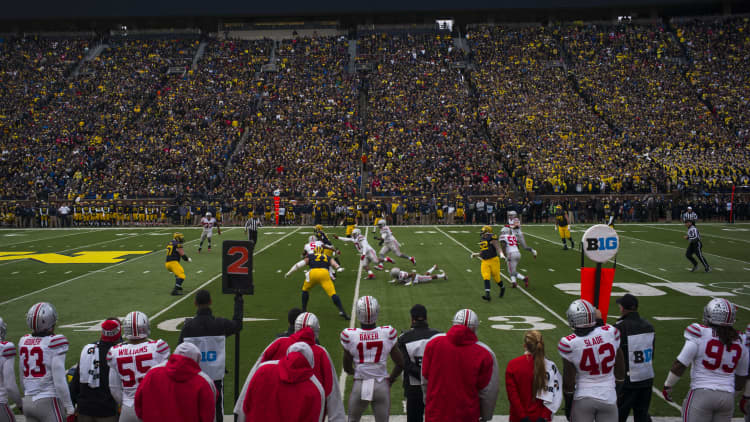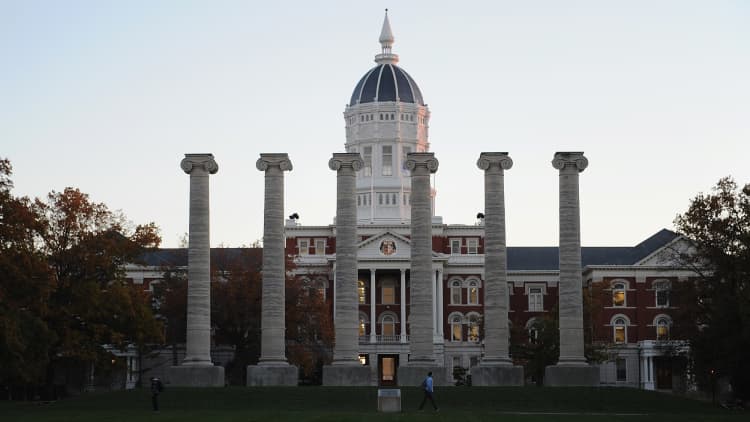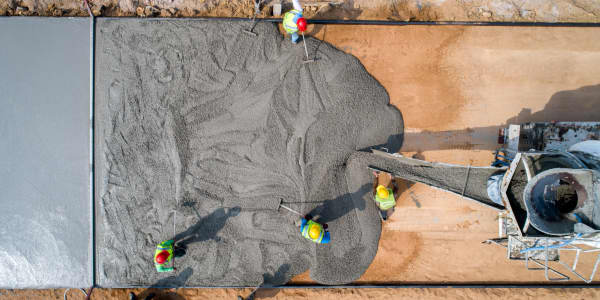The college football doomsday clock is about to strike midnight as the fallout from the coronavirus pandemic inches the upcoming season closer to cancellation.
With U.S. cases over 70,000 per day and an increasing number of notable athletic departments, such as Ohio State, Clemson and Oklahoma, reporting positive tests among student athletes, optimism about playing college football in 2020 has faded. NCAA President Mark Emmert expressed concerns about the worsening virus trends in a statement this week, saying, "If there is to be college sports in the fall, we need to get a much better handle of the pandemic."
Now mere weeks away from training camps, the NCAA faces a difficult decision: With so much money on the line, is it possible, or even worth it, to play college football this season?
According to a recent survey by Stadium, athletic directors at big conference programs have downgraded their outlook for a normal start to the season, with many expecting a delay beyond the Aug. 29 official start for college football and predicting conference games only. Some ADs are voicing their worst concerns, if anonymously.
"Right now I don't see a path in the current environment to how we play," an anonymous Power Five athletic director told Yahoo Sports. "I'm confident we'll get back to what we all think of as normal, but it may be a year before that happens."
The cost of a canceled season
Still, in the Stadium survey, only 11% expect a canceled season. An outright cancellation would devastate the college sports economy. Football is the industry's primary revenue engine, and a lost season could wipe out $4 billion in total revenue, according to ESPN. The implications would reach far beyond the field itself.
"I don't think anyone in the country is in a position that I'm aware of [to] weather not having football," Iowa State athletic director Jamie Pollard said.
Iowa State was fortunate. Pollard was briefed on the impending crisis when he visited New York City in early March as part of his duties on the NCAA Men's Division I Basketball Committee. Not long after the sports world had ground to a halt, Pollard negotiated salary reductions in his athletic department, postponed a price hike in season ticket and donor payments and instituted requestable Covid-19 refunds or deferrals on tickets. Pollard says the moves bought additional goodwill with his fan base and, as a result, resulted in a steady stream of ticket renewals and donations.
Iowa State also audited its roughly $30 million to $35 million reserves to reorient necessary funds to back the athletic department's $86 million budget if need be. Pollard says the exercise estimated a 25% hit even if football is played with fans. Football accounts for 30% of the athletic expenses and 75% of its revenue.
In an open letter to the Iowa State community, Pollard wrote the outright cancellation of fall sports could result in a $40 million loss. But knowing he had around $12 million to $15 million from the reserve budget to play with helps "navigate in a way that allows me to get through this." Between Iowa State's reserve budget and Pollard's early glimpse of what the country was about to face, the university was in a position to act in ways most schools couldn't.
"I could sense we were going to die of a thousand cuts if we didn't do something really quick," Pollard said.
Months before football concerns were even on the table, the virus already had made a significant impact. Scrubbing March Madness cost schools a reported total of $375 million and prompted the cancellation of all spring sports. University of North Carolina-Charlotte professor of economics Dr. Craig Depken says the college sports industry is overcapitalized — programs, mainly the bigger ones, spend an excessive amount of money on amenities, stadiums, coaches and trainers. It's a form of nonprice competition, since schools can't pay their players. Depken estimates only a handful of programs have significant athletic reserves, so without the cash flow of the upcoming season, colleges aren't prepared to stomach the "rainy day" scenario of a lost season.
Drastic cuts by Stanford and others
Pollard's efforts saved Iowa State from making more severe financial cuts in the short term. Many other schools were forced to take more drastic action.
Since the start of the Covid-19 pandemic, schools have cut, dropped or suspended 61 Division I teams and 176 programs across all NCAA levels, according to data from MatTalkOnline.com. Nearly 20% of cuts have affected tennis programs. It's an astronomical increase, considering only 57 programs were dropped in the last three years. That was before Stanford announced it was eliminating 11 varsity sports in anticipation of a $70 million shortfall over the next three years.
For the college sports landscape, Stanford hurts even more because of its importance to the U.S. Olympic program. Reducing non-revenue sports as a whole will hurt the U.S.' ability to compete internationally — Axios reported 88% of American athletes at the 2016 Rio Games played their sport collegiately. Stanford supplied 29 Olympians in 2016 and has collected 270 Olympic medals total.
The sheer volume of non-revenue program cuts illustrate a concerning trend. Under financial constraints, schools are more likely to eliminate smaller sports than to trim gluttonous football budgets. Back in May, there was a general optimism that college football would be played because of the enormous financial incentive alone. It was more a question of what universities would do to mitigate risks and get fans in the stands.
"My primary fear is for the health and safety of our student athletes, our staff and our fan base," University of South Florida vice president of athletics Michael Kelly said at the time. "So once we can do the things that are deemed appropriate by the government, university, conference and NCAA that we can proceed, then we'll proceed and have to adjust accordingly like everyone else will."
During an appearance on WDAE 95.3 Tampa Bay Sports Radio, Kelly spoke to the protocols his department implemented in early June as athletes returned to campus for voluntary workouts. Like many other institutions across the country, USF athletes worked out in small groups, and when someone did test positive, USF mandated quarantines and engaged in contact tracing.
While he did call the situation "highly concerning," Kelly wouldn't speculate whether football would be delayed or canceled this season, committing to waiting things out and staying flexible. USF does have contingencies in place, including a scenario where they only play American Athletic Conference games.
Major conferences prepare for worst
Other conferences are already preparing for the worst. The MEAC, Ivy and Patriot Leagues took the plunge and canceled fall sports in 2020, while the CAA scrubbed its upcoming football season. The Big Ten and PAC-12 announced their switch to conference-only play this season, a move that provides flexibility, reduces travel costs and limits outside variables. The rest of the Power Five is expected to follow.
While the Power Five schools have a shot at recouping some revenue through TV contracts, the scheduling shift is a dagger to smaller conferences. Iowa State, for example, receives north of $40 million in BIG 12 TV money, whereas a school like USF gets only around $5 million in conference revenue. Smaller conference schools are much more reliant on gate revenue and other sources of income, such as agreements to play "buy games" against larger conference schools. The Big Ten agreed to pay non-conference opponents at least $22.2 million this season, and in 2018 similar games across the sport totaled $175 million, according to USA Today.
As far as fans returning to the stands, there's no universal arrangement in place. Capacity restrictions and mitigation efforts will depend on local authorities. Iowa State is limiting capacity at 50% to coincide with state regulations. Additionally, the university plans to "reduce the time parking lots are open for tailgating, require face coverings to enter the stadium, move to digital ticketing, install additional hand sanitizer stations, change entrance procedures, modify concession operations, as well as many other initiatives."

USF's venue situation is a bit more unique, as the university plays its game at Raymond James Stadium, the home of the Tampa Bay Buccaneers. Kelly noted this as a strength, saying the larger, pro-style stadium is more conducive to social distancing. Whatever measures the NFL deems necessary to stage games will inherently spill over to USF's game-day protocols. But with the stadium inside the city of Tampa, USF has less control of the situation and is at the whim of the local government. And right now Florida is a Covid-19 hot spot, with more than 300,000 confirmed cases in the state.
The damage could be even more devastating to the local economies. Limiting fan attendance could place a severe financial strain on some of the areas so heavily reliant on the stimulus brought in by football, from hotels to restaurants, tailgating and tourism.
The severity varies by region. In May, Pollard said hotels in Ames, Iowa, lost an estimated $3 million over six weeks. The city was averaging a decrease of 5,000 hotel rooms per week. With demand generally higher during football season, that trend could escalate further in the fall.
These small towns live and die by this.Dr. Craig DepkenUniversity of North Carolina-Charlotte professor of economics
For some towns football is everything. Depken cited Prairie View, Texas, home to Prairie View A&M University, as a glaring example. The school completed a new, 15,000-seat stadium in 2016, despite being a town of only roughly 6,500 people. Depken says the school's intention with its new facility was to drive enrollment rates up, and research shows hosting a football game has "tremendous economic benefits" in the form of inviting new stimulus into the town that would have been spent elsewhere.
"That just kind of tells you how these small towns live and die by this," Depken said.
As catastrophic as a lost season could be, the absence of football could spell a much more concerning trend for the higher-education industry. If there's no football, Pollard says it's directly indicative of the U.S. Covid-19 situation being so bad students can't return to campus. While college football could cost its industry $4 billion, the higher-education industry, expected to cross $2 trillion in value by 2026, according to Zion Market Research, would be looking at a much more significant loss.
The Wall Street Journal reported schools were spending millions to install safety measures such as Plexiglass, face masks, touchless hand sanitizer dispensers and other protective equipment for both students and staff. Purdue University budgeted $50 million for safety measures, including 5 miles of Plexiglass.
The expenses are rising dramatically as revenues continue to vanish. On top of the health-care supplies, schools are saddled with decreasing enrollment, refunded housing fees and the costs of shifting online. University of Akron's president, Gary L. Miller, announced in early May the school would cut six of its 11 colleges due to an expected $65 million to $70 million decrease in revenue.
Based on Iowa State's internal review, the hit to Iowa State's athletic budget could fall between $15 million and $20 million. However, it pales in comparison to the impact at the university level. Pollard says the university's total budget is around $1.5 billion, and the estimated blow to the university might amount to 10 times what athletics is facing.
"Higher education is going to be hemorrhaging," Pollard said. "If things are bad in athletics, it's bad in higher education."
The economic implications are altogether startling, and recovery could be a multiyear process. But equal consideration must be given to the collective health of the country. If there's one thing Covid-19 trends have shown in the last few months, it's how quickly they change.
For Pollard and many of his colleagues, optimism has shifted to caution. The only real way to know is to see how things play out.
"I think we will know a lot more in [a few] weeks," Pollard said. "When actual practice is scheduled to start."






